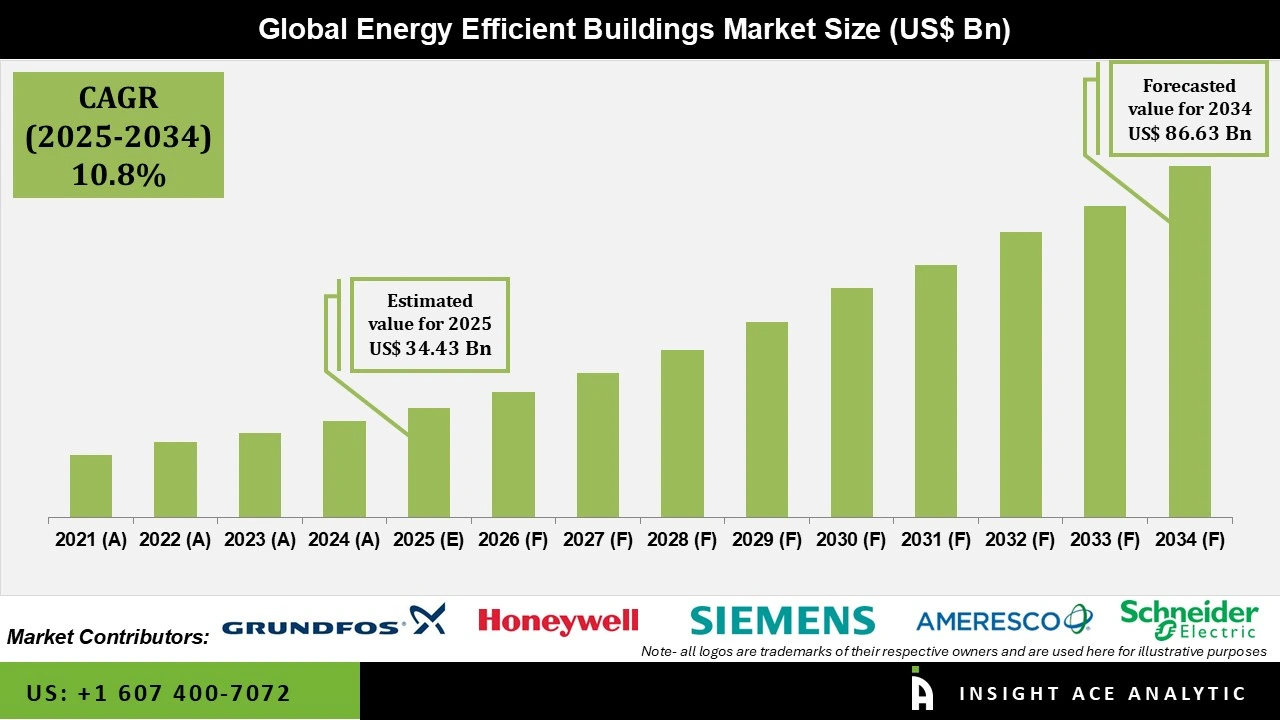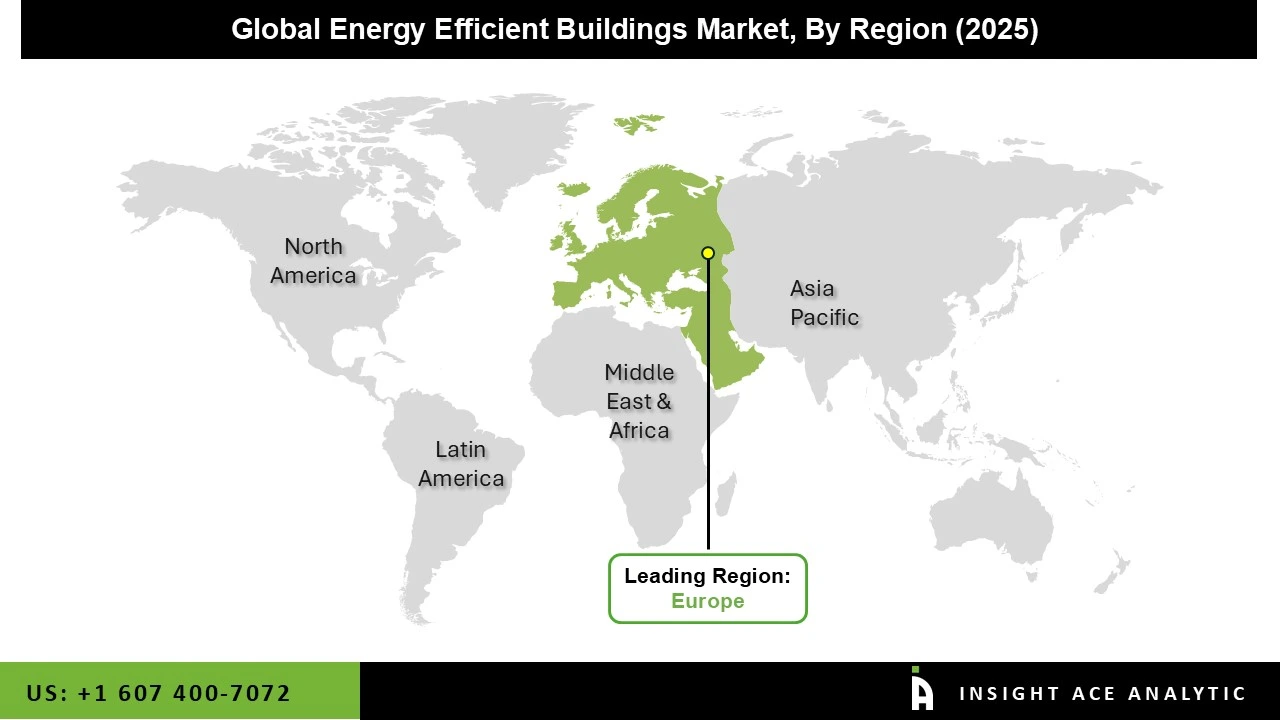Global Energy Efficient Buildings Market is valued at US$ 34.53 Bn in 2025 and it is expected to reach US$ 86.63 Bn by 2034, with a CAGR of 10.8% during the forecast period of 2025-2034.
Energy-efficient buildings save energy, reduce electricity bills, and improve indoor air quality. They use smart insulation, natural light, efficient heating/cooling systems, and solar power to stay comfortable while using much less energy. These buildings help cities cut pollution and handle growing energy needs. They make spaces affordable, healthy, and eco-friendly. The global energy-efficient buildings market is growing fast as energy prices rise and governments push for greener construction.

Rising electricity costs drive demand for energy-efficient buildings. Businesses and homeowners want long-term savings through smart designs and upgrades. For example, the U.S. government invested $2 billion in 150 federal building projects across 39 states using sustainable materials. Stricter building codes, climate change concerns, and corporate sustainability goals also boost adoption. Companies and developers see energy efficiency as both a cost-saver and a competitive advantage.
High initial costs for insulation, smart systems, and solar panels remain a major barrier. However, these investments pay back through lower utility bills within 3-7 years. Government incentives make projects more affordable. New technologies—AI building controls, advanced windows, and energy-storing materials—are becoming cheaper and more effective. As costs drop and benefits become clearer, energy-efficient buildings will become standard worldwide.
Some of the Key Players in the Energy Efficient Buildings Market:
The energy efficient buildings market is segmented by building type and component. By building type, the market is segmented into commercial, residential, infrastructure, and industrial. By component, the market is segmented into lighting technology, ventilation systems, controls, energy management systems, and others.
The Commercial category led the Energy Efficient Buildings market in 2024. In order to accomplish sustainability objectives and lower carbon emissions, governments and regulatory agencies around the world have come to understand the significance of energy efficiency in commercial buildings. Commercial building owners and developers have been motivated to invest in energy-efficient technologies & practices by strict building requirements, energy efficiency standards, and financial incentives. Additionally, energy-efficient solutions offer significant long-term operational benefits, and commercial building owners and operators frequently seek cost savings.
The largest and fastest-growing Component is Lighting Technology, a trend driven by the rapid technological developments that have occurred in the lighting business, especially since LED (Light Emitting Diode) technology has become widely used. Compared to conventional incandescent and fluorescent lighting, LED lighting is more ecologically friendly, long-lasting, and energy efficient. The use of energy-efficient lighting systems has increased as a result. Additionally, governments all around the world have put laws and incentives in place to encourage energy-efficient lighting. T
Europe led the energy-efficient buildings market in 2024 due to strict construction laws and energy regulations. The Energy Performance of Buildings Directive (EPBD) sets high standards for energy efficiency, pushing developers to use smart designs and materials from the planning stage. European countries prioritize sustainable practices, ensuring buildings reduce energy use and environmental impact. This strong regulatory framework makes Europe the global leader in energy-efficient construction.

Asia-Pacific is the fastest-growing energy-efficient buildings market, driven by rapid urbanization, rising energy costs, and government policies. Cities like Singapore, China, and India face huge energy demands from new construction, forcing developers to adopt smart building technologies. Cost savings from lower utility bills and strict green building codes accelerate adoption. Governments invest heavily in energy-efficient infrastructure, making the region a growth leader.
· In March 2024, Grundfos Holding A/S launched the "Grundfos iSOLUTIONS" platform with new AI-driven energy optimization features for commercial building circulator pumps. The updated platform uses real-time data and predictive algorithms to automatically adjust pump speed and system pressure, reducing a building's HVAC energy consumption by up to 20% compared to standard pumps.
Chapter 1. Methodology and Scope
1.1. Research Methodology
1.2. Research Scope & Assumptions
Chapter 2. Executive Summary
Chapter 3. Global Energy Efficient Buildings Market Snapshot
Chapter 4. Global Energy Efficient Buildings Market Variables, Trends & Scope
4.1. Market Segmentation & Scope
4.2. Drivers
4.3. Challenges
4.4. Trends
4.5. Investment and Funding Analysis
4.6. Porter's Five Forces Analysis
4.7. Incremental Opportunity Analysis (US$ MN), 2025-2034
4.8. Global Energy Efficient Buildings Market Penetration & Growth Prospect Mapping (US$ Mn), 2024-2034
4.9. Competitive Landscape & Market Share Analysis, By Key Player (2024)
4.10. Use/impact of AI on Energy Efficient Buildings Market Industry Trends
Chapter 5. Energy Efficient Buildings Market Segmentation 1: By Building Type, Estimates & Trend Analysis
5.1. Market Share by Building Type, 2024 & 2034
5.2. Market Size (Value (US$ Mn) & Forecasts and Trend Analyses, 2021 to 2034 for the following Building Type:
5.2.1. Commercial
5.2.2. Residential
5.2.3. Infrastructure
5.2.4. Industrial
Chapter 6. Energy Efficient Buildings Market Segmentation 2: By Component, Estimates & Trend Analysis
6.1. Market Share by Component, 2024 & 2034
6.2. Market Size (Value (US$ Mn) & Forecasts and Trend Analyses, 2021 to 2034 for the following Component:
6.2.1. Lighting Technology
6.2.2. Ventilation Systems
6.2.3. Controls
6.2.4. Energy Management Systems
6.2.5. Others
Chapter 7. Energy Efficient Buildings Market Segmentation 3: Regional Estimates & Trend Analysis
7.1. Global Energy Efficient Buildings Market, Regional Snapshot 2024 & 2034
7.2. North America
7.2.1. North America Energy Efficient Buildings Market Revenue (US$ Mn) Estimates and Forecasts by Country, 2021-2034
7.2.1.1. US
7.2.1.2. Canada
7.2.2. North America Energy Efficient Buildings Market Revenue (US$ Mn) Estimates and Forecasts by Building Type, 2021-2034
7.2.3. North America Energy Efficient Buildings Market Revenue (US$ Mn) Estimates and Forecasts by Component, 2021-2034
7.3. Europe
7.3.1. Europe Energy Efficient Buildings Market Revenue (US$ Mn) Estimates and Forecasts by Country, 2021-2034
7.3.1.1. Germany
7.3.1.2. U.K.
7.3.1.3. France
7.3.1.4. Italy
7.3.1.5. Spain
7.3.1.6. Rest of Europe
7.3.2. Europe Energy Efficient Buildings Market Revenue (US$ Mn) Estimates and Forecasts by Building Type, 2021-2034
7.3.3. Europe Energy Efficient Buildings Market Revenue (US$ Mn) Estimates and Forecasts by Component, 2021-2034
7.4. Asia Pacific
7.4.1. Asia Pacific Energy Efficient Buildings Market Revenue (US$ Mn) Estimates and Forecasts by Country, 2021-2034
7.4.1.1. India
7.4.1.2. China
7.4.1.3. Japan
7.4.1.4. Australia
7.4.1.5. South Korea
7.4.1.6. Hong Kong
7.4.1.7. Southeast Asia
7.4.1.8. Rest of Asia Pacific
7.4.2. Asia Pacific Energy Efficient Buildings Market Revenue (US$ Mn) Estimates and Forecasts by Building Type, 2021-2034
7.4.3. Asia Pacific Energy Efficient Buildings Market Revenue (US$ Mn) Estimates and Forecasts by Component, 2021-2034
7.5. Latin America
7.5.1. Latin America Energy Efficient Buildings Market Revenue (US$ Mn) Estimates and Forecasts by Country, 2021-2034
7.5.1.1. Brazil
7.5.1.2. Mexico
7.5.1.3. Rest of Latin America
7.5.2. Latin America Energy Efficient Buildings Market Revenue (US$ Mn) Estimates and Forecasts by Building Type, 2021-2034
7.5.3. Latin America Energy Efficient Buildings Market Revenue (US$ Mn) Estimates and Forecasts by Component, 2021-2034
7.6. Middle East & Africa
7.6.1. Middle East & Africa Energy Efficient Buildings Market Revenue (US$ Mn) Estimates and Forecasts by country, 2021-2034
7.6.1.1. GCC Countries
7.6.1.2. Israel
7.6.1.3. South Africa
7.6.1.4. Rest of Middle East and Africa
7.6.2. Middle East & Africa Energy Efficient Buildings Market Revenue (US$ Mn) Estimates and Forecasts by Building Type, 2021-2034
7.6.3. Middle East & Africa Energy Efficient Buildings Market Revenue (US$ Mn) Estimates and Forecasts by Component, 2021-2034
Chapter 8. Competitive Landscape
8.1. Major Mergers and Acquisitions/Strategic Alliances
8.2. Company Profiles
8.2.1. Grundfos Holding A/S
8.2.1.1. Business Overview
8.2.1.2. Key Product/Service
8.2.1.3. Financial Performance
8.2.1.4. Geographical Presence
8.2.1.5. Recent Developments with Business Strategy
8.2.2. Honeywell International Inc
8.2.3. Schneider Electric SE
8.2.4. Ameresco Inc.
8.2.5. Siemens AG
8.2.6. ABB Ltd
8.2.7. Johnson Controls Inc.
8.2.8. GridPoint, Inc.
8.2.9. Pacific Controls Cloud Services (PCCS)
8.2.10. KMC Controls
Energy Efficient Buildings Market by Building Type-
· Commercial
· Residential
· Infrastructure
· Industrial
Energy Efficient Buildings Market by Component -
· Lighting Technology
· Ventilation Systems
· Controls
· Energy Management Systems
· Others
Energy Efficient Buildings Market by Region-
North America-
· The US
· Canada
Europe-
· Germany
· The UK
· France
· Italy
· Spain
· Rest of Europe
Asia-Pacific-
· China
· Japan
· India
· South Korea
· Southeast Asia
· Rest of Asia Pacific
Latin America-
· Brazil
· Argentina
· Mexico
· Rest of Latin America
Middle East & Africa-
· GCC Countries
· South Africa
· Rest of the Middle East and Africa